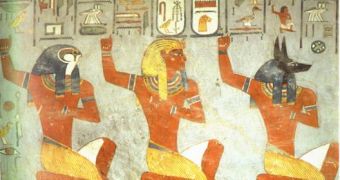It has already been known as the largest pharaoh tomb in the Valley of the Kings. Now it appears that the tomb of Seti I, who ruled Egypt between 1313-1292 BC, is larger than originally believed. In 1817, Giovanni Battista Belzoni measured the tomb as being 328 ft (107 m) long. The new research shows its real length to be 446 ft (136 m).
"[This is] the largest tomb and this is longest tunnel that's ever found in any place in the Valley of the Kings. And we still did not find its end until now," Zahi Hawass, secretary general of Egypt's Supreme Council of Antiquities (SCA), told National Geographic News.
"I think this tunnel [in the tomb of Seti I] will lead to something important," said Mansour Boraik, director of Luxor Antiquities.
The tomb impresses not only through its sheer size, but also through its wall art. The digging revealed clay vessels, painted wall reliefs, and a quartzite ushabti funerary statue.
"These objects could have washed into the tunnel during floods starting from the 21st dynasty, between 1090 and 945 B.C. Pharaohs from the 21st dynasty onward quarried the tombs of their predecessors for their own royal burials," archaeologist W. Raymond Johnson, director of the Epigraphic Survey of the Oriental Institute at the University of Chicago, told National Geographic News.
The mummies of the predecessor kings were reburied in hidden cachette tombs, like in the case of Amenhotep II, found close to the tomb of Seti I. The quarry also involved filling in the deep shafts (wells) cut into the ground of the tomb after the second entry corridor, in order to ease the removal of heavy rock blocks from the tomb. The shafts were meant to connect with the underworld, but in fact they protected the tombs against floods.
"These shafts would catch [rainwater] before it went to the burial chamber and divert it downward. But [many of] these [shafts] got filled in order to drag the sarcophagi out, and they didn't clear them out. The filled-in shafts left tombs susceptible to flooding from rainwater. Other locations in the Valley of the Kings, such as KV5 and the tomb of Ramses II, show signs of such flooding," said Johnson.
Following the 1994 torrential rains, protective raised edges surrounding the royal tombs were raised by SCA. The tomb escaped earlier excavations because a small part of the vaulted ceiling of the burial chamber had collapsed and its digging was considered too dangerous.

 14 DAY TRIAL //
14 DAY TRIAL //